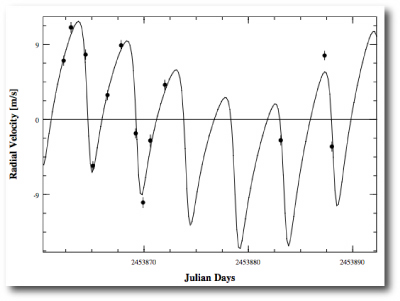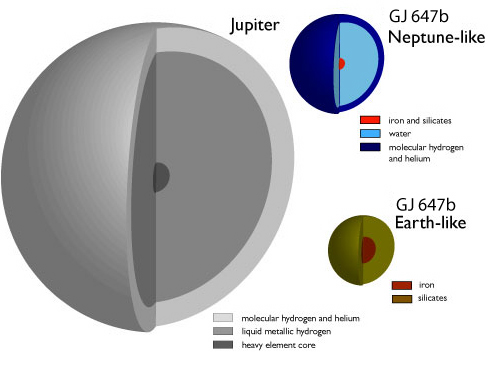
Image Source.
Word up! Chalk a jet-fresh Neptune on the boards — the Swiss’ve done it again.
The red dwarf GJ 674 lies 14.67 light years away. Minus 49 Dec. Only 53 known stars are closer to the Sun, and at V=9.382, GJ 674 is slightly more than twice as bright in the optical as its far more famous cousin GJ 876. With ~35% of the Sun’s mass, it’s packing more heat as well.

According to the Bonfils et al. discovery preprint posted to astro-ph yesterday, GJ 674 is accompanied by a sub-Neptune mass planet on a 4.6938 day orbit. Bucking the recent trends, the paper doesn’t contain a tabulation of the radial velocities. Eugenio, however, made dextrous use of the Dexter to scrape them off the figures, and they’re now safely packaged into the downloadable Systemic Console. The star has also been added to the “Real Stars” catalog on the Systemic Backend. The internal errors on the velocities are mostly below 1 m/s, which is impressive, given that each data point is based on a 15-minute integration of a rather dim star.
This discovery is a exciting for several reasons. Most immediate, is the fact that the planet does not yet seem to have been fully followed up photometrically to check for transits. At first glance, such an effort might appear to be hampered by the fact that the star is young enough to show significant photometric variability in synch with its 35-day rotation period. A central transit, however, would have a duration of only ~80 minutes — much shorter than starspot-induced variations — and would generate a clearly detectable dip of at least ~0.5% photometric depth.
Transitsearch.org has observers in Australia, South Africa, and South America, and so I’m hoping that they can quickly take advantage of this opportunity. The next transit window is centered about 15 hours from now, on April 06, 2007 at 20:38 UT. Here’s looking at you, Perth. The ephemeris table showing all the upcoming opportunities is at transitsearch.org. Based on a radius estimate for the star of 0.35 solar radii, the geometric transit probability is ~5.0%. Roll that twenty-sided die.
It’s fair to say that the next major discovery in the exoplanet game will likely be the detection of transits of a short-period Neptune-mass planet. Quite a few players are scrambling to be the first in the door. If it isn’t done from the ground during the next 6-months, then it’s likely that CoRoT will take the prize.
There’s a large difference in radius between sub-Neptune-mass planets made from rock and iron and sub-Neptunes composed mostly of water:

A Neptune transiting one of the brightest M-dwarfs in the sky would be a huge big deal. Hundreds of citations, Dude. Even if there’s no transit, this planet will likely be an excellent candidate for observation in the long-wavelength Spitzer bands, and fortunately there’s one more GO cycle before that cryogen runs out.

Pingback: Centauri Dreams » Blog Archive » A New Red Dwarf Planet
total – 10 – hot neptune
4 around М, 6 around G and K star
period around Ðœ – 2,5,5,3 days ; average = 4 days
period around G and K – 9, 10, 3, 15, 17, 4 days ; average = 10 days
radius orbits G and K – 0.1 a.u., M – 0.04 a.u.
diametr М =(150/0.3)=0.002 a.u.
diametr G =(1/150)=0.007 a.u.
geometric probability G = 14%, M = 5%
total geometric probability hot neptune = 14%*6 + 5%*4=84%+20%=104% !!!
Pingback: systemic - Bali Hai